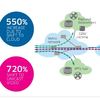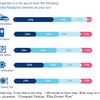Kabel Deutschland (KD), a Vodafone company, is a good example of what cable multiple system operators must do to gracefully manage growing demand and continue to deliver innovative new services by upgrading their network edge for IP services.
As highlighted in a recent TechZine article by Steve Davidson, European Marketing Director for Cable, Alcatel-Lucent, KD’s investment in infrastructure and cable services had already paid great dividends. The company’s initial 100 Mb/s product offering had a take-rate approaching 50 percent. But with this positive consumer response came some new challenges.
Among these challenges were managing cable operator costs and subscriber growth, supporting legacy cable services, and accelerating IP service deployment. How the cable company dealt with these problems and did so in the context of having a vision of its IP services future is worth studying.
First, KD knew that it needed to continue to support subscriber growth from its current base of 8.4 million connected households in Germany, so it adopted a flexible, simplified edge architecture that enabled it to address scaling, cost and functionality issues at the edge of its network to help manage its growing business.
Second, supporting legacy services was important for the cable MSO even while it increasingly rolled out ultra-broadband for cable, so KD looked for an architecture that would support both legacy IPv4 and new IPv6.
The company also wanted to make sure the new architecture had the flexibility to accommodate long-term growth and next generation service delivery without compromising KD’s reputation for high performance and high value services, and the company found it with Alcatel-Lucent’s cable MSO solutions.
Third, KD needed to accelerate deployment. The company studied future market needs and analyzed the options available for both the near and longer term, and opted for highly redundant clusters of dual-stack edge devices in an architecture that can separate IP service routing from the access technology.
“This approach can also simplify the existing cable hub and make it possible for KD to deliver personalized and differentiated services across whichever access technologies are in use,” noted Anderson in his article. “The solution resolved KD’s immediate IPv4 address challenges and set up the company for a high growth IP services future that included the use of IPv6.”
The separation of service routing and access helped speed up deployment of IP services and allowed KD to migrate smoothly to whichever new technologies evolve down the line.












